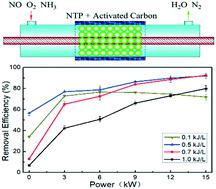当前位置:
X-MOL 学术
›
React. Chem. Eng.
›
论文详情
Our official English website, www.x-mol.net, welcomes your feedback! (Note: you will need to create a separate account there.)
Diesel engine exhaust denitration using non-thermal plasma with activated carbon
Reaction Chemistry & Engineering ( IF 3.9 ) Pub Date : 2020-07-28 , DOI: 10.1039/d0re00227e Zongyu Wang 1, 2, 3, 4 , Hailang Kuang 1, 2, 3, 4 , Jifeng Zhang 1, 2, 3, 4, 5 , Wei Zhang 1, 2, 3, 4 , Lilin Chu 1, 2, 3, 4 , Chunrong Yu 1, 2, 3, 4 , Yulong Ji 1, 2, 3, 4
Reaction Chemistry & Engineering ( IF 3.9 ) Pub Date : 2020-07-28 , DOI: 10.1039/d0re00227e Zongyu Wang 1, 2, 3, 4 , Hailang Kuang 1, 2, 3, 4 , Jifeng Zhang 1, 2, 3, 4, 5 , Wei Zhang 1, 2, 3, 4 , Lilin Chu 1, 2, 3, 4 , Chunrong Yu 1, 2, 3, 4 , Yulong Ji 1, 2, 3, 4
Affiliation

|
Vanadium-based catalysts are often used in selective catalytic reduction (SCR) technology for abating NOx in diesel engine exhaust. However, their poor catalytic ability at low temperature, high toxicity and cost are big turnoffs. In this paper, the combination of non-thermal plasma (NTP) generated by dielectric barrier discharge and activated carbon (AC) is used to remove NOx from diesel engine exhaust. The results show that the denitration efficiency of the NTP + AC + NH3 system can reach 91.8% after 1 hour of NTP action at 0.5 kJ L−1 energy density for simulated exhaust gas. The AC characterization results show that NTP increases the specific surface area of AC. AC is rather stable at 300 °C and the NTP + AC + NH3 system can maintain high denitration efficiency for at least 5 hours. For real exhaust gas, the denitration efficiencies of the NTP + AC + NH3 system can reach 92.5% (>300 °C) and 76.9% (<200 °C), respectively. There is great potential for NTP + AC + NH3 technology to be a possible replacement for vanadium-based SCR in diesel engine exhaust denitration.
中文翻译:

使用非热等离子体和活性炭的柴油机排气脱硝
钒基催化剂通常用于选择性催化还原(SCR)技术中,以减轻柴油机排气中的NO x。然而,它们在低温下较差的催化能力,高毒性和成本是很大的缺点。在本文中,电介质阻挡层放电产生的非热等离子体(NTP)与活性炭(AC)的结合被用于去除柴油机排气中的NO x。结果表明,在模拟废气中,NTP + AC + NH 3系统在0.5 kJ L -1能量密度下,经过1小时的NTP处理后,脱硝效率可达到91.8%。AC表征结果表明,NTP增加了AC的比表面积。AC在300°C时相当稳定,而NTP + AC + NH 3系统可以保持至少5小时的高脱硝效率。对于实际废气,NTP + AC + NH 3系统的脱硝效率分别可以达到92.5%(> 300°C)和76.9%(<200°C)。NTP + AC + NH 3技术在柴油机排气脱硝中有可能替代钒基SCR。
更新日期:2020-08-25
中文翻译:

使用非热等离子体和活性炭的柴油机排气脱硝
钒基催化剂通常用于选择性催化还原(SCR)技术中,以减轻柴油机排气中的NO x。然而,它们在低温下较差的催化能力,高毒性和成本是很大的缺点。在本文中,电介质阻挡层放电产生的非热等离子体(NTP)与活性炭(AC)的结合被用于去除柴油机排气中的NO x。结果表明,在模拟废气中,NTP + AC + NH 3系统在0.5 kJ L -1能量密度下,经过1小时的NTP处理后,脱硝效率可达到91.8%。AC表征结果表明,NTP增加了AC的比表面积。AC在300°C时相当稳定,而NTP + AC + NH 3系统可以保持至少5小时的高脱硝效率。对于实际废气,NTP + AC + NH 3系统的脱硝效率分别可以达到92.5%(> 300°C)和76.9%(<200°C)。NTP + AC + NH 3技术在柴油机排气脱硝中有可能替代钒基SCR。


























 京公网安备 11010802027423号
京公网安备 11010802027423号